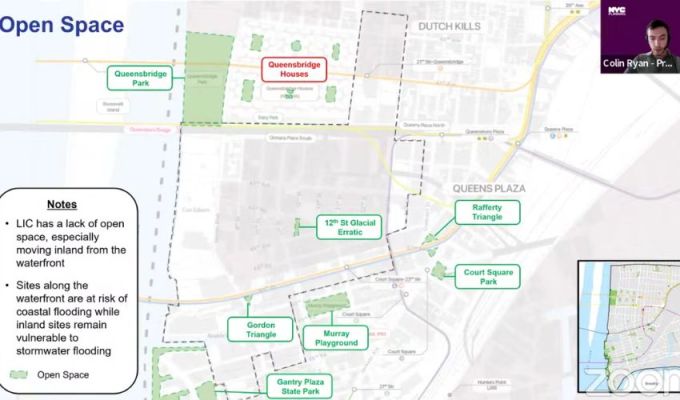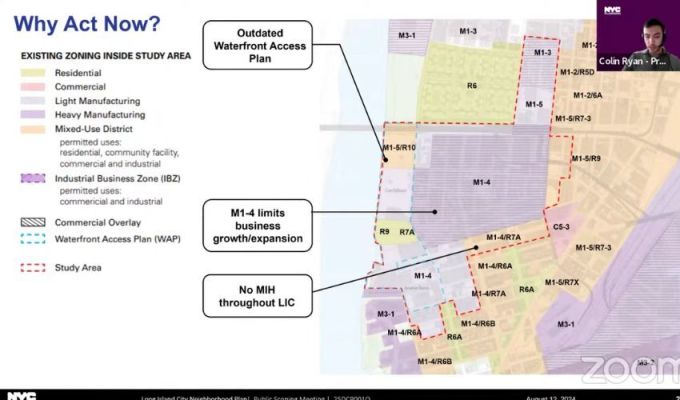
Photo LICplan.nyc
Aug. 13, 2024 By Shane O’Brien
A combination of elected officials and local residents called for increases to affordable housing, public spaces, and environmental measures in the One LIC neighborhood plan at the Department of City Planning’s virtual public scoping meeting on Monday afternoon.
Monday’s meeting, which took place over Zoom over the course of three hours, was a remote public scoping hearing that invited elected officials and members of the public to take part in the preparation of the Draft Environmental Impact Statement (DEIS), which aims to identify the economic impacts of the One LIC plan.

DCP Borough Planner Colin Ryan discusses open space during Monday’s scoping hearing.
Council Member Julie Won, State Senator Kristen Gonzalez, and representatives for Congresswoman Nydia Velázquez and Assemblymember Zohran Mamdani were among those to address Monday’s meeting, while representatives from Plaxall, Hunters Point Parks Conservancy, and the Long Island City Partnership also addressed the event.
Members of the public are invited to submit written recommendations until 5 p.m. on Friday, September 13.
At the end of the written comment period, the Department of City Planning (DCP) will determine what changes, if any, need to be made to the Draft Scope of Work, which has been produced following 16 previous public events since November last year, engaging more than 1,000 members of the local community and receiving more than 4,000 comments.
Speaking on Monday, Council Member Won and State Sen. Gonzalez both criticized the decision to hold the scoping hearing in August at a time when many members of the local community were unable to attend.
“I want to put on the record that I am displeased that the Department of City Planning did not schedule this hearing for September, despite numerous requests from myself, the community board, community groups, as well as the overlapping elected officials,” Won said at Monday’s scoping hearing. “I want to make sure that our community continues to be notified that there is an extension for written testimony.”
Gonzalez, meanwhile, called for the comment deadline to be extended beyond September 13.

Screenshots from Monday’s virtual meeting
The neighborhood plan proposes significant zoning changes to the local area and encompasses the area from Gantry Plaza State Park on the East River to Queensbridge Houses and the Long Island City Industrial Business Zone in the north. It also stretches east to Court Square and 23rd Street and recommends investments and programming for all of Long Island City, including Queensbridge.
At a town hall in June, representatives from the DCP said the One LIC plan will create 16,000 new homes, at least 4,000 of which will be affordable, and 16,000 new jobs across various sectors.
DCP officials said the plan will also create 7-9 acres of public space on the LIC waterfront, several new schools, safer streets, support for existing businesses and protection for existing tenants.
Robert White, a representative of AKRF, an environmental consultant firm working on the One LIC plan, told Monday’s meeting that as many as 65 potential new developments could be added to the area by 2035 as part of the One LIC plan.

Screenshots from Monday’s virtual meeting
Gonzalez raised concerns about the potential environmental impact of adding so many developments to the area over the next decade.
“The Long Island City neighborhood plan must be scrutinized for its profound implications on our community,” Gonzalez said. “Long Island City is already grappling with serious deficits in open space and resiliency. These problems will only worsen with additional development unless addressed comprehensively.
“It is imperative to address these concerns now,” Gonzalez added, stating that the neighborhood plan could have adverse impacts on open space, water and sewer infrastructure, traffic and public transportation, natural resources, and air quality.
“This area is already suffering serious consequences from over-development, and it is essential to ensure that any development in this area benefits the community and addresses existing deficits.
“We are certainly concerned about 50 potential development sites, if not more. I think that’s a significant number that is new for the community.”
She said a significant increase in high-rise buildings may exacerbate existing problems by increasing problems of flooding due to stormwater runoff.
Gonzalez, Won, and representatives for Velázquez and Mamdani all called for increases in affordable housing in the One LIC plan.
“This (One LIC) will only result in 4,000 affordable housing units,” Won said. “That is not enough. This will compound the existing pattern of unaffordable development in our neighborhood.”

Screenshots from Monday’s virtual meeting
Speaking on behalf of Velázquez, Dan Wiley called for affordable housing in the One LIC neighborhood plan to go beyond the bare minimum.
“We need to maximize affordable housing beyond the minimum required under the mandatory inclusionary housing program,” Wiley said. “We must not displace residents or cultural institutions and businesses, but rather grow deeply affordable housing.”
Wiley added that New York’s infrastructure is not sufficient to fight climate change and said new developments could put pressure on sewers, risking overflow, contamination, and spillover effects. Any new development must not add to existing problems, Wiley said.
Wiley also said Velázquez is calling for the 561,000 sq ft Department of Education building at 44-36 Vernon Blvd. to be used as a cultural space for local artists.
“We need to preserve not only the culture of Long Island City but create communal space for services. The DOE building as a re-imagined and transformed space would create new jobs and allow small businesses and working artists to remain and thrive in Long Island City.”
Edjo Wheeler, Executive Director of Culture Lab, echoed Wiley’s calls for support for local artists.
“What becomes of a neighborhood when its artists, creators, and visionaries are pushed out?” Wheeler said. “As we stand on the brink of major changes in LIC, this isn’t just a rhetorical question.
“We hear very little mention of arts and culture when it comes to these plans. Let’s change that.”
Hunters Point Parks Conservancy Executive Director Jessica Sechrist praised Won for kickstarting a comprehensive neighborhood plan rather than taking a piecemeal approach to the local area and commended the DCP for pledging to invest in existing parks along the LIC waterfront.
Sechrist noted that LIC ranks among the worst neighborhoods in New York City in terms of green space per capita and said the neighborhood plan must include enhanced public spaces, sewage infrastructure, and transportation.
Long Island City Partnership (LICP) President Laura Rothrock said the LICP supported most aspects of the plan but added that more could be done to connect the industrial business zone (IBZ), located between Court Square and the LIC waterfront, with the rest of the neighborhood.
“Many people bypass local establishments and jump on the subway into Manhattan out of convenience,” Rothrock said. “We hear from employers that they have trouble retaining staff who are concerned about walking to the subway in the IBZ, which is dimly lit and not pedestrian friendly.”
Bishop Mitchel Taylor, CEO of Urban Upbound, called for the current neighborhood plan to be expanded beyond Queensbridge Houses, expanding the study from 40th Avenue to 37th Avenue in the north.
Bishop Taylor said redrawing the borders of the neighborhood plan would significantly increase the potential of affordable housing while also enhancing light manufacturing and industry.
“I think this would be a tremendous opportunity to create at least 10,000 units of next-level affordable housing for residents that live in Queensbridge Houses, teachers, custodians, FDNY NYPD, all of which can use affordable housing,” Bishop Taylor said.
A number of participants said they do not feel comfortable walking to commercial stores in the IBZ due to poor lighting, while others called for significant increases in the number of schools in the local area.

Community ideas from a previous in-person town hall. (Photo NYC Planning)
DCP officials also noted that the most common feedback they had received from local residents included comments that existing zoning stunts business growth and development, while the Long Island City waterfront is outdated and doesn’t meet modern standards for resiliency and open space design.
The DCP will continue to accept feedback through September 13, with further town halls and community focus meetings to solicit further community feedback set to take place over fall and winter. A draft neighborhood plan is due to be submitted next spring.
The draft plan will finalize zoning changes through ULURP, with new zoning, policies and programs expected to be announced by fall 2025.
One LIC was announced by Won, the DCP, and WXY Studios last year as a holistic community planning process to gain input on a comprehensive neighborhood plan.
One Comment

Good Luck !